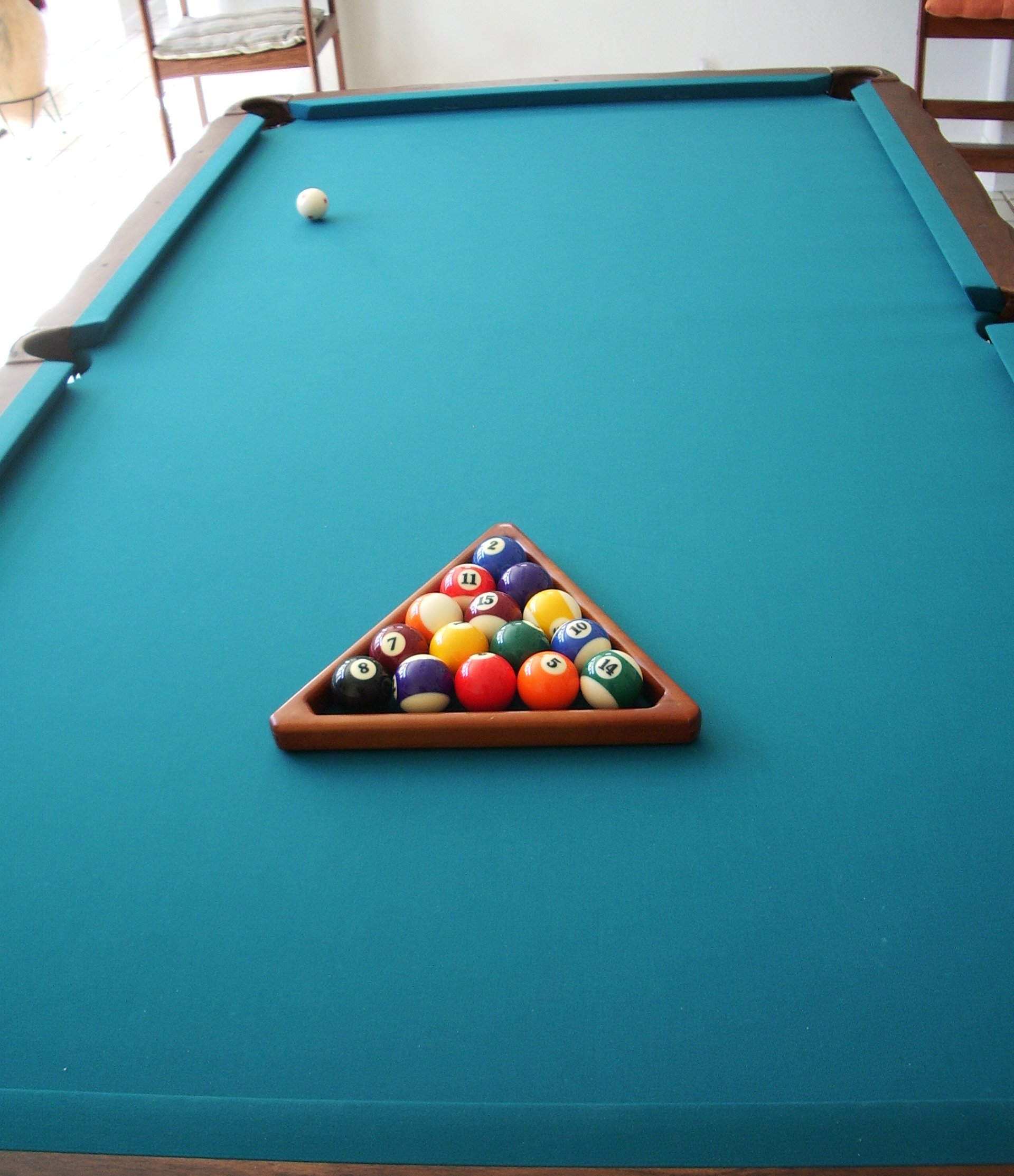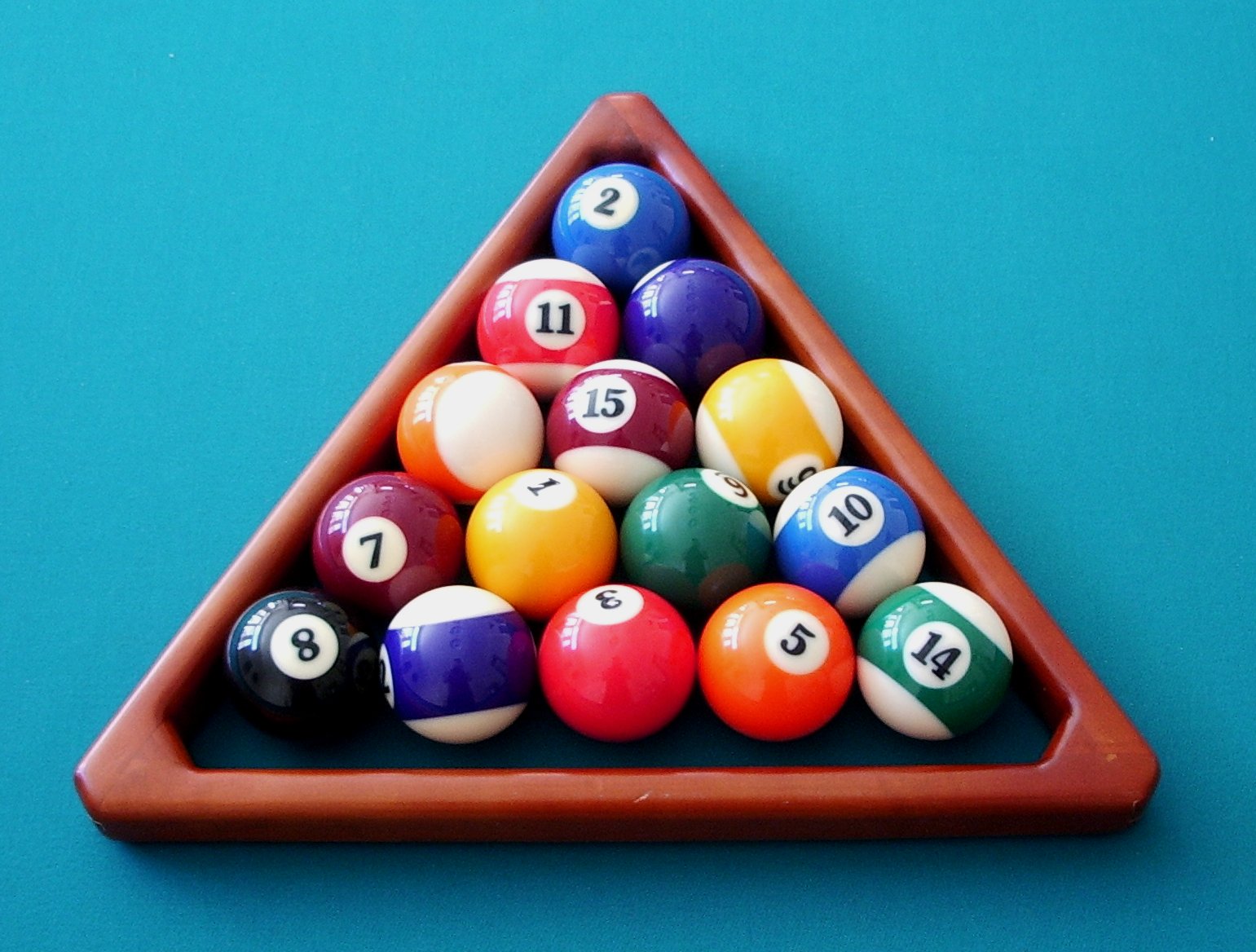Cribbage Pool on:
[Wikipedia]
[Google]
[Amazon]
 Cribbage, sometimes called cribbage pool, fifteen points and pair pool, is a two-player pool game that, like its namesake card game, has a scoring system which awards points for pairing groups of balls (rather than playing cards) that total 15. Played on a standard pool table, participants who a ball of a particular number are required to immediately pocket the companion ball that tallies to 15 when added to the prior ball's number. Each pair so pocketed counts as a cribbage; there are seven such pairs, and the 15 ball counts as an eighth by itself after all of the others have been pocketed. The first player to score five cribbages wins the game.
Cribbage, sometimes called cribbage pool, fifteen points and pair pool, is a two-player pool game that, like its namesake card game, has a scoring system which awards points for pairing groups of balls (rather than playing cards) that total 15. Played on a standard pool table, participants who a ball of a particular number are required to immediately pocket the companion ball that tallies to 15 when added to the prior ball's number. Each pair so pocketed counts as a cribbage; there are seven such pairs, and the 15 ball counts as an eighth by itself after all of the others have been pocketed. The first player to score five cribbages wins the game.
 At the start of cribbage, a standard set of fifteen pool balls are racked at the end of a pool table, with the of the rack centered over the and the 15 ball placed at the rack's center. All other balls are placed randomly except that no two of the three corner balls may total to fifteen. Such an open-ended racking rule is unusual in that most pool games require particular balls to be placed at the corners of the rack and sometimes in fixed positions inside the rack as well. The arrangement thus results in 134,120,448,000 possible racking patterns (14 × 12 × 10 × 2 × 11 !).
An is required in cribbage, meaning that on the either a ball must be pocketed or at least four balls must be driven to rails (as opposed to a ). The object of the game is to score 5 cribbages out of a possible 8 in a full rack of 15 balls.
At the start of cribbage, a standard set of fifteen pool balls are racked at the end of a pool table, with the of the rack centered over the and the 15 ball placed at the rack's center. All other balls are placed randomly except that no two of the three corner balls may total to fifteen. Such an open-ended racking rule is unusual in that most pool games require particular balls to be placed at the corners of the rack and sometimes in fixed positions inside the rack as well. The arrangement thus results in 134,120,448,000 possible racking patterns (14 × 12 × 10 × 2 × 11 !).
An is required in cribbage, meaning that on the either a ball must be pocketed or at least four balls must be driven to rails (as opposed to a ). The object of the game is to score 5 cribbages out of a possible 8 in a full rack of 15 balls.
General rules of pocket billiards: Rules 3.10, 3.18 and 3.19
. Retrieved March 15, 2007. When a player pockets more than one ball on a single at any time, a situation often arising on the , they may shoot at any companion balls, but must pocket each in succession in any order. If incidental balls are pocketed on the same stroke that a cribbage is completed, they add to the succession of cribbages the player is "on". When a player fouls by failing to pocket an unpaired cribbage while on a succession of unpaired balls, only unpaired balls are spotted; the prior successful cribbages count toward the score. Normal ball and rail foul rules apply in cribbage. This is a requirement present in most pool games that a player must contact an with the cue ball and after that contact, either pocket an object ball, or some ball including the cue ball must contact a rail. When a foul results from a , where the cue ball is played into a pocket or jumping it off the table, the opposing player has cue ball in hand from the kitchen. When a player has cue ball in hand from the kitchen and all object balls are also behind the head string in the , a player has the option of having the object ball nearest the head string relocated to the foot spot. If in this situation two or more object balls are equidistantly closest to the head string, the player may designate which ball is to be relocated.
 Cribbage, sometimes called cribbage pool, fifteen points and pair pool, is a two-player pool game that, like its namesake card game, has a scoring system which awards points for pairing groups of balls (rather than playing cards) that total 15. Played on a standard pool table, participants who a ball of a particular number are required to immediately pocket the companion ball that tallies to 15 when added to the prior ball's number. Each pair so pocketed counts as a cribbage; there are seven such pairs, and the 15 ball counts as an eighth by itself after all of the others have been pocketed. The first player to score five cribbages wins the game.
Cribbage, sometimes called cribbage pool, fifteen points and pair pool, is a two-player pool game that, like its namesake card game, has a scoring system which awards points for pairing groups of balls (rather than playing cards) that total 15. Played on a standard pool table, participants who a ball of a particular number are required to immediately pocket the companion ball that tallies to 15 when added to the prior ball's number. Each pair so pocketed counts as a cribbage; there are seven such pairs, and the 15 ball counts as an eighth by itself after all of the others have been pocketed. The first player to score five cribbages wins the game.
Gameplay
Setup
 At the start of cribbage, a standard set of fifteen pool balls are racked at the end of a pool table, with the of the rack centered over the and the 15 ball placed at the rack's center. All other balls are placed randomly except that no two of the three corner balls may total to fifteen. Such an open-ended racking rule is unusual in that most pool games require particular balls to be placed at the corners of the rack and sometimes in fixed positions inside the rack as well. The arrangement thus results in 134,120,448,000 possible racking patterns (14 × 12 × 10 × 2 × 11 !).
An is required in cribbage, meaning that on the either a ball must be pocketed or at least four balls must be driven to rails (as opposed to a ). The object of the game is to score 5 cribbages out of a possible 8 in a full rack of 15 balls.
At the start of cribbage, a standard set of fifteen pool balls are racked at the end of a pool table, with the of the rack centered over the and the 15 ball placed at the rack's center. All other balls are placed randomly except that no two of the three corner balls may total to fifteen. Such an open-ended racking rule is unusual in that most pool games require particular balls to be placed at the corners of the rack and sometimes in fixed positions inside the rack as well. The arrangement thus results in 134,120,448,000 possible racking patterns (14 × 12 × 10 × 2 × 11 !).
An is required in cribbage, meaning that on the either a ball must be pocketed or at least four balls must be driven to rails (as opposed to a ). The object of the game is to score 5 cribbages out of a possible 8 in a full rack of 15 balls.
Cribbages
A cribbage is a pair of numbered balls which, when added together, total 15. A cribbage only lies where the two partner balls forming the cribbage are each legally , i.e., where no is committed on the same strokes that pocket the balls, or the shot is otherwise deemed illegal. The one exception to pairing is the , which itself becomes a cribbage but only once all other have been pocketed.Rules of play
A cribbage only counts when the paired balls are pocketed in succession in the same . When a player first pockets a ball, it is described as ''on a cribbage''. If, on the next stroke, the companion ball is not pocketed, the shot is a foul and the unpaired ball is to the . If the foot spot is occupied, balls are spotted as close as possible to the foot spot on the stretching back from the foot spot to the . The penalty for all fouls is the ending of the player's inning; no points are lost, and the incoming player has the option of shooting from position or taking from the (behind the table's ). In older rules a foul was a loss of one point. Three successive fouls in cribbage is a loss of game. Pocketing the 15-ball when it is not the last ball on the table is ''not a foul''. Instead it is immediately spotted and play continues without penalty.Billiard Congress America (1995–2005)General rules of pocket billiards: Rules 3.10, 3.18 and 3.19
. Retrieved March 15, 2007. When a player pockets more than one ball on a single at any time, a situation often arising on the , they may shoot at any companion balls, but must pocket each in succession in any order. If incidental balls are pocketed on the same stroke that a cribbage is completed, they add to the succession of cribbages the player is "on". When a player fouls by failing to pocket an unpaired cribbage while on a succession of unpaired balls, only unpaired balls are spotted; the prior successful cribbages count toward the score. Normal ball and rail foul rules apply in cribbage. This is a requirement present in most pool games that a player must contact an with the cue ball and after that contact, either pocket an object ball, or some ball including the cue ball must contact a rail. When a foul results from a , where the cue ball is played into a pocket or jumping it off the table, the opposing player has cue ball in hand from the kitchen. When a player has cue ball in hand from the kitchen and all object balls are also behind the head string in the , a player has the option of having the object ball nearest the head string relocated to the foot spot. If in this situation two or more object balls are equidistantly closest to the head string, the player may designate which ball is to be relocated.
References
{{DEFAULTSORT:Cribbage (Pool) Pool (cue sports)